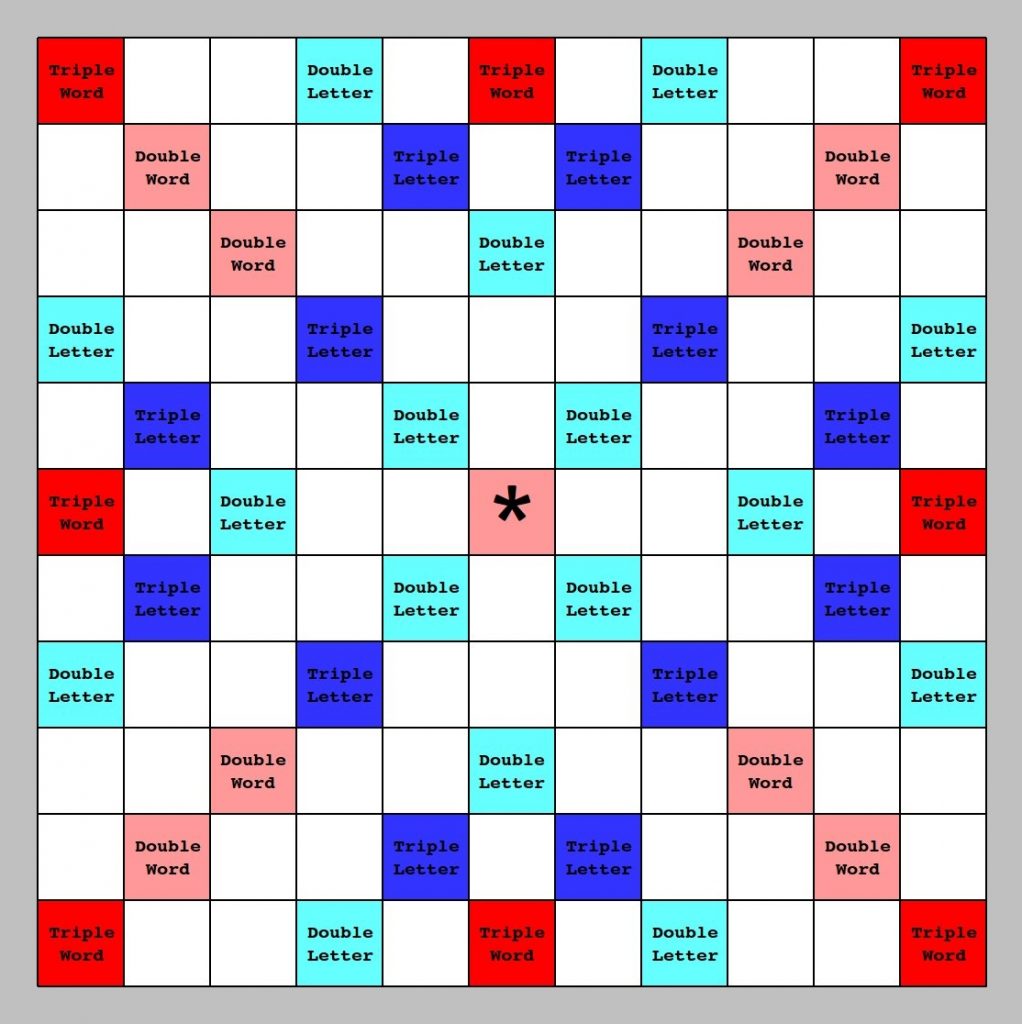Excuse the intentional misspelling to avoid copyright searches.
I enjoy a good game of Scrabble, which is a nice combination of skill and luck. It’s also a fundamentally “nice” game in that everyone plays until the end. You don’t eliminate players from the game, and the game does not encourage unpleasant behaviour, unlike games such as Monopoly.
But there are three problems with holding a game of Scrabble: (1) finding players, (2) travelling with the game is difficult, and (3) lost pieces can’t be replaced. There’s not much one can do about the first except meet new people, but something can be done about the game. Read on….
A standard Scrabble board is 15×15 squares, or 225 spaces. With 100 pieces, that’s 0.444… pieces per square. To make the game more portable, I created a new 11×11 board with 121 squares. This new board is 53.777…% of the original size, so it gets 54 pieces. There are 60 bonus squares on a 15×15 board, or 26.666…% (not counting the centre). A reduced Scrabble board has 44 bonus squares, or 36.363636…%.
You can print the image below or create your own within a spreadsheet. Make the cells 2cm x 2cm with borders, and use colours or four different grey scale backgrounds (e.g. two solid, two with pinstripes). I split a spreadsheet into two parts (six and five columns) and printed them on two pieces of sticking A4 size paper (or 8.5″x11″). Ten carefully placed and aligned the pieces on thick hard card (2mm or 3mm works best).

A standard Scrabble set has 100 pieces in this distribution:
- 2 blank tiles (scoring 0 points)
- 1 point: E ×12, A ×9, I ×9, O ×8, N ×6, R ×6, T ×6, L ×4, S ×4, U ×4
- 2 points: D ×4, G ×3
- 3 points: B ×2, C ×2, M ×2, P ×2
- 4 points: F ×2, H ×2, V ×2, W ×2, Y ×2
- 5 points: K ×1
- 8 points: J ×1, X ×1
- 10 points: Q ×1, Z ×1
Reduced Scrabble has 54 pieces in this distribution:
- 2 blank tiles (scoring 0 points)
- 1 point: E ×7, A ×5, I ×5, O ×4, N ×3, R ×3, T ×3, L ×2, S ×2, U ×2
- 2 points: D ×2, G ×2
- 3 points: B ×1, C ×1, M ×1, P ×1
- 4 points: F ×1, H ×1, V ×1, W ×1, Y ×1
- 5 points: K ×1
- 8 points: X ×1
- 10 points: Q or Z ×1
I intentionally excluded J and give players the choice of Q or Z. Other more usable letters could be substituted by player preference (e.g. a second H instead of K) or if pieces are missing.
Game play:
- Each player takes five pieces per turn. (In original and reduced, players only need one piece to reach two Triple Word squares.)
- A player using all five tiles in one turn receives a 20 point bonus. (Using all five is far easier than using seven.)
- All other standard Scrabble scoring rules apply.
If anyone has suggestions or amendments, let me know.

I used to really like scrabble, until I took one of those “fluff” college courses on scrabble…
I don’t know, it may still be enjoyable to play with friends, but playing with hyper-competitive people was very much not an enjoyable experience for me. Also, I’m still bitter that “zen” wasn’t officially allowed, but some obscure Islamic hat was…
Anyways, about the time I took that course, I also bought a “travel scrabble” that I thought was pretty decent, it had a folding board, and smaller tiles, and it all was contained in a zipped-up fabric container, maybe something like ~10″x6″x2.5″ The tiles are about ~1/2″ square, and sorta snap into the board surface. also the trays for the tiles can close over them, containing them and obscuring them, so it is somewhat suitable for play whilst in transit.
There is still the problem with #3, in that I don’t think the tiles can be replaced if broken/lost, short of buying a new game set and combining them.
anyways, I just did a really brief check on google and amazon, and it looks like it may not be in current production anymore, that’s too bad…
The best way to play against hypercompetitive people (or at least, stronger versus weaker players) is handicapping. Evaluate player ability and vocabulary, then decide on a percentage.
I teach ESL and play it with kids whose English is limited. To even up gameplay, I take a big handicap (60-75%) and maybe give them an extra piece or two. I also remove letters that are more difficult to use (e.g. J, Q, X, etc.). If a kid scores 10 points, I have to score 40 to break even. It levels out player ability and forces everyone to play their best. The hard part is getting skilled players to accept it.